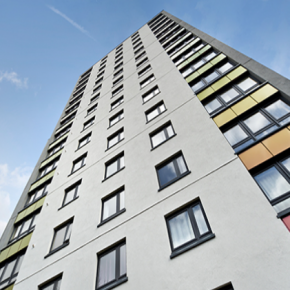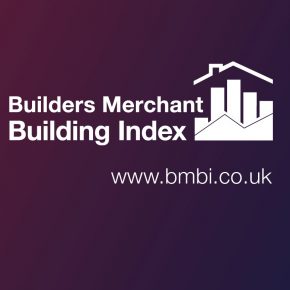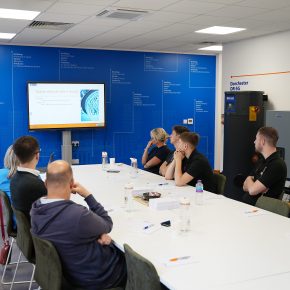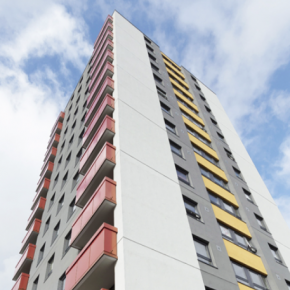
What specifiers should look for in their EWI system
Alumasc’s Technical Director Mark Gibbs discusses what specifiers should look for in their EWI system for high-rise and the importance of safe installation.
Specification for the multi-storey application of External Wall Insulation is very different to that of low-rise projects, with health and safety procedures being a key consideration in the thermal upgrade of high-rise buildings.
High rise projects for the last 25 years have been refurbished using EWI, as a cost effective method of achieving thermal and aesthetic upgrade of buildings.
EWI solves the issue of condensation, water ingress and poor thermal performance of many of the blocks and provides a U-value to comply with current Building Regulations.
The appropriate type of EWI insulation board is mechanically and adhesively fixed to the substrate to achieve the thermal requirements of the project. A polymer modified reinforcing base coat, incorporating a fibreglass reinforcement mesh, is then applied.
Various finishes are available, ranging from traditional dash or painted renders to more modern through-coloured silicone renders, once it has fully cured.
The insulation boards of high-rise EWI specification must be adhesively and mechanically fixed. To accommodate higher wind loads, calculations must be made and the edge zones, and increased mechanical fixings are required for external corners and openings.
The calculations must always be conducted by Structural Engineering Consultants to ensure structural stability, required performance and system longevity.
For use in high-rise application, specified EWI systems must be officially accredited and approved. The system requires a large scale fire test or reaction to fire test when used above 18m in height.
There are additional detailing considerations compared to low-rise, as well as through-the-wall square metre rates. Including parapet, lightening conductor, CCTV, external lights, robust window cill details, ground floor entrance areas etc.
It is critical that all detailing is robust and installed as per specification .Any repairs are more difficult and costly to address than for low-rise projects once the wall access is removed. Scaffold ties should be fixed in the most practical locations and protected scaffolding is recommended.
Mast climbers are an economical and faster track option for EWI install, however they offer less protection to newly installed work. Programming considerations should always allow for weather conditions.
Alumasc Facades,
White House Works,
Bold Road,
Sutton,
St Helen's,
Merseyside,
United Kingdom
WA9 4JG
Phone: 01744 648400
Visit Supplier's page
Latest news

25th April 2024
BMBI: Value sales in first two months were -3.4% down
The latest Builders Merchant Building Index (BMBI) report shows builders’ merchants’ value sales were down -4.7% in February compared to the same month a year ago.
Posted in Articles, Bathrooms & Toilets, Bathrooms, Bedrooms & Washrooms, Bricks & Blocks, Building Associations & Institutes, Building Industry News, Building Products & Structures, Building Services, Civil Engineering, Concrete, Cement, Admixtures, Drainage, Floors, Hard Landscaping & Walkways, Interior Design & Construction, Interiors, Landscaping, news, Paints, Paints, Coatings & Finishes, Plant, Equipment and Hire, Plumbing, Posts, Publications, Research & Materials Testing, Restoration & Refurbishment, Retrofit & Renovation, Sustainability & Energy Efficiency
24th April 2024
The lowdown on Origin’s New Soho Offering
Origin’s Soho External Door is the first launch in its new generation of products, setting a higher standard for the fenestration industry.
Posted in Access Control & Door Entry Systems, Aluminium Products, Architectural Ironmongery, Articles, Building Industry News, Building Products & Structures, Building Systems, Doors, Innovations & New Products, Posts, Restoration & Refurbishment, Retrofit & Renovation, Security and Fire Protection
24th April 2024
Mitsubishi Electric welcomes new code of conduct for smart appliances
Mitsubishi Electric welcomes a new code of conduct on energy smart appliances which the European Union (EU) announced yesterday at the Hannover Fair in Germany.
Posted in Air Conditioning, Articles, Building Industry Events, Building Industry News, Building Products & Structures, Building Regulations & Accreditations, Building Services, Exhibitions and Conferences, Facility Management & Building Services, Heating Systems, Controls and Management, Heating, Ventilation and Air Conditioning - HVAC, Plumbing, Retrofit & Renovation, Seminars, Sustainability & Energy Efficiency
24th April 2024
Hamworthy Heating expands CIBSE approved CPD modules with new hot water series
Hamworthy Heating, technical experts in commercial heating and hot water products, announce the expansion of its market leading CIBSE approved Continuing Professional Development (CPD) portfolio with the launch of three new learning modules.
Posted in Articles, Building Industry Events, Building Industry News, Building Products & Structures, Building Services, Continuing Professional Development (CPD's), Facility Management & Building Services, Heating Systems, Controls and Management, Heating, Ventilation and Air Conditioning - HVAC, Plumbing, Retrofit & Renovation, Seminars, Training
 Sign up:
Sign up: 